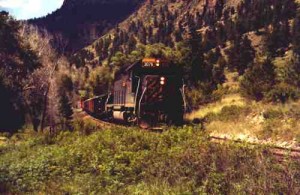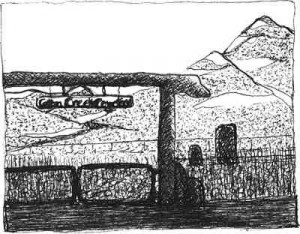Brief by Central Staff
Nomenclature – February 2006 – Colorado Central Magazine
In our January edition, we misspelled the artist Christo’s name in a headline on page 9; we had it as Cristo.
We knew better and we apologize, but we can point to two mitigating factors. One is that when you’re proofreading, mistakes in body type for some reason are easier to spot than mistakes in bigger headline type. (Our publisher’s most memorable error in that department came 34 years ago on a weekly newspaper in Longmont; he left the r out of Britches on a headline that was supposed to say Little Britches Rodeo starts Saturday.)
The other mitigating factor is that hereabouts, it’s usually Cristo, as in the Sangre de Cristo mountains which extend for about 250 miles from Salida to south of Santa Fé.
Sangre de Cristo means “blood of Christ” in Spanish, but that’s about as far as anyone can reliably trace the origin of the name. It supposedly refers to the red hue of the peaks at sunset.
It was in use by 1779. Juan Bautista de Anza’s campaign journal for Sept. 3 of that year reports that after winning the battle against the Comanche southwest of Pueblo, “I started the march to the south. Due to favorable terrain we made 5 leagues before arriving at the first water, an arroyo of the Sangre de Cristo, where we stopped for the night.”
But that name was not known to Capt. Zebulon M. Pike, who crossed the range at Medano Pass during his 1806- 07 expedition. He called them the “Snow Mountains,” the “White Mountains,” and the “White Snow Mountains.” (Pike’s map of Central Colorado is reproduced on page 20 of this edition.)
The best relevant reference book we’ve found is now out of print, alas. It’s Mountain Names by Robert Hixson Julyan, and it was published in 1984 by The Mountaineers of Seattle. He notes that “The romantic appeal of the name Sangre de Cristo has inspired [apocryphal explanations] of its origin. One says that the mountains were named during the Pueblo Revolt of 1680, when the Pueblo Indians of New Mexico rose up to murder their Spanish oppressors. According to legend, a dying padre named Juan asked for a sign from heaven. When the mountains he beheld turned red at sunset, he exclaimed ‘Sangre de Cristo!'”
Julyan theorizes that the Sangres actually got their name from the Penitentes, a religious and fraternal order of Roman Catholic men in southern Colorado and northern New Mexico: “The naming of the Sangre de Cristo Mountains, in those villages the Penitentes are still an important part of community life, seems associated with the rise of the sect and what has been called ‘its accentuated devotion to the Passion and Death of the Savior.’ Among the Penitentes, the name Sangre de Cristo gave the mountains great religious significance. Before that name became accepted, the mountains were called the Sierra Madre Mountains, mother range, but the Penitente name is the one that has survived.
That’s as good an explanation as we could find, but the editors failed to learn what they wanted to know elsewhere in Julyan’s book. The name Quillen almost certainly comes from the Cuillin Hills of Scotland. And what does Cuillin mean? “The place names of western Scotland are among the oldest in Britain. Their original meanings have long been lost, however, and even the language in which they were originally spoken is only a conjecture.”


